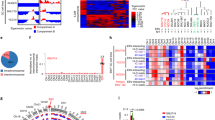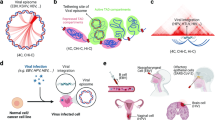Abstract
The cancerous cellular state is associated with multiple epigenetic alterations, but elucidating the precise order of such alterations during tumorigenic progression and their contributions to the transformed phenotype remains a significant challenge in cancer biology. Here we discuss recent findings on how viral oncoproteins exploit specific epigenetic processes to coerce normal cells to replicate when they should remain quiescent — a hallmark of cancer. These findings may highlight roles of epigenetic processes in normal biology and shed light on epigenetic events occurring along the path of non-viral neoplastic transformation.
This is a preview of subscription content, access via your institution
Access options
Subscribe to this journal
Receive 12 print issues and online access
$189.00 per year
only $15.75 per issue
Buy this article
- Purchase on Springer Link
- Instant access to full article PDF
Prices may be subject to local taxes which are calculated during checkout


Similar content being viewed by others
References
Fraga, M. F. et al. Loss of acetylation at Lys16 and trimethylation at Lys20 of histone H4 is a common hallmark of human cancer. Nature Genet. 37, 391–400 (2005).
Seligson, D. B. et al. Global histone modification patterns predict risk of prostate cancer recurrence. Nature 435, 1262–1266 (2005).
Berk, A. J. Recent lessons in gene expression, cell cycle control, and cell biology from adenovirus. Oncogene 24, 7673–7685 (2005).
Mujtaba, S. et al. Epigenetic transcriptional repression of cellular genes by a viral SET protein. Nature Cell Biol. 10, 1114–1122 (2008).
Liu, X. & Marmorstein, R. Structure of the retinoblastoma protein bound to adenovirus E1A reveals the molecular basis for viral oncoprotein inactivation of a tumor suppressor. Genes Dev. 21, 2711–2716 (2007).
Ferrari, R. et al. Epigenetic reprogramming by adenovirus e1a. Science 321, 1086–1088 (2008).
Chakravarti, D. et al. A viral mechanism for inhibition of p300 and PCAF acetyltransferase activity. Cell 96, 393–403 (1999).
Horwitz, G. A. et al. Adenovirus small e1a alters global patterns of histone modification. Science 321, 1084–1085 (2008).
Green, M., Panesar, N. K. & Loewenstein, P. M. The transcription-repression domain of the adenovirus E1A oncoprotein targets p300 at the promoter. Oncogene 27, 4446–4455 (2008).
Xu, X. et al. A comprehensive ChIP–chip analysis of E2F1, E2F4, and E2F6 in normal and tumor cells reveals interchangeable roles of E2F family members. Genome Res. 17, 1550–1561 (2007).
Spindler, K. R. & Berk, A. J. Rapid intracellular turnover of adenovirus 5 early region 1A proteins. J. Virol. 52, 706–710 (1984).
Zhang, Q., Yao, H., Vo, N. & Goodman, R. H. Acetylation of adenovirus E1A regulates binding of the transcriptional corepressor CtBP. Proc. Natl Acad. Sci. USA 97, 14323–14328 (2000).
Whalen, S. G. et al. Phosphorylation within the transactivation domain of adenovirus E1A protein by mitogen-activated protein kinase regulates expression of early region 4. J. Virol. 71, 3545–3553 (1997).
Frisch, S. M. & Mymryk, J. S. Adenovirus-5 E1A: paradox and paradigm. Nature Rev. Mol. Cell Biol. 3, 441–452 (2002).
Li, J. et al. CBP/p300 are bimodal regulators of Wnt signaling. EMBO J. 26, 2284–2294 (2007).
Webster, K. A., Muscat, G. E. & Kedes, L. Adenovirus E1A products suppress myogenic differentiation and inhibit transcription from muscle-specific promoters. Nature 332, 553–557 (1988).
Varambally, S. et al. The polycomb group protein EZH2 is involved in progression of prostate cancer. Nature 419, 624–629 (2002).
Peng, W., Togawa, C., Zhang, K. & Kurdistani, S. K. Regulators of cellular levels of histone acetylation in Saccharomyces cerevisiae. Genetics 179, 277–289 (2008).
Takahashi, K. et al. Induction of pluripotent stem cells from adult human fibroblasts by defined factors. Cell 131, 861–872 (2007).
O'Connor, M. J., Zimmermann, H., Nielsen, S., Bernard, H. U. & Kouzarides, T. Characterization of an E1A–CBP interaction defines a novel transcriptional adapter motif (TRAM) in CBP/p300. J. Virol. 73, 3574–3581 (1999).
Yang, X. J., Ogryzko, V. V., Nishikawa, J., Howard, B. H. & Nakatani, Y. A p300/CBP-associated factor that competes with the adenoviral oncoprotein E1A. Nature 382, 319–324 (1996).
Burgers, W. A. et al. Viral oncoproteins target the DNA methyltransferases. Oncogene 26, 1650–1655 (2007).
Fuchs, M. et al. The p400 complex is an essential E1A transformation target. Cell 106, 297–307 (2001).
Lang, S. E. & Hearing, P. The adenovirus E1A oncoprotein recruits the cellular TRRAP/GCN5 histone acetyltransferase complex. Oncogene 22, 2836–2841 (2003).
Adamson, A. L. & Kenney, S. The Epstein–Barr virus BZLF1 protein interacts physically and functionally with the histone acetylase CREB-binding protein. J. Virol. 73, 6551–6558 (1999).
Wang, L., Grossman, S. R. & Kieff, E. Epstein–Barr virus nuclear protein 2 interacts with p300, CBP, and PCAF histone acetyltransferases in activation of the LMP1 promoter. Proc. Natl Acad. Sci. USA 97, 430–435 (2000).
Cotter, M. A. 2nd & Robertson, E. S. Modulation of histone acetyltransferase activity through interaction of Epstein–Barr nuclear antigen 3C with prothymosin alpha. Mol. Cell Biol. 20, 5722–5735 (2000).
Swenson, J. J., Holley-Guthrie, E. & Kenney, S. C. Epstein–Barr virus immediate-early protein BRLF1 interacts with CBP, promoting enhanced BRLF1 transactivation. J. Virol. 75, 6228–6234 (2001).
Zheng, D. L. et al. Epigenetic modification induced by hepatitis B virus X protein via interaction with de novo DNA methyltransferase DNMT3A. J. Hepatol. 50, 377–387 (2009).
Li, M. et al. Inhibition of p300 histone acetyltransferase by viral interferon regulatory factor. Mol. Cell. Biol. 20, 8254–8263 (2000).
Hwang, S., Gwack, Y., Byun, H., Lim, C. & Choe, J. The Kaposi's sarcoma-associated herpesvirus K8 protein interacts with CREB-binding protein (CBP) and represses CBP-mediated transcription. J. Virol. 75, 9509–9516 (2001).
Shamay, M., Krithivas, A., Zhang, J. & Hayward, S. D. Recruitment of the de novo DNA methyltransferase Dnmt3a by Kaposi's sarcoma-associated herpesvirus LANA. Proc. Natl Acad. Sci. USA 103, 14554–14559 (2006).
Gwack, Y., Byun, H., Hwang, S., Lim, C. & Choe, J. CREB-binding protein and histone deacetylase regulate the transcriptional activity of Kaposi's sarcoma-associated herpesvirus open reading frame 50. J. Virol. 75, 1909–1917 (2001).
Lee, D., Lee, B., Kim, J., Kim, D. W. & Choe, J. cAMP response element-binding protein-binding protein binds to human papillomavirus E2 protein and activates E2-dependent transcription. J. Biol. Chem. 275, 7045–7051 (2000).
Peng, Y. C., Breiding, D. E., Sverdrup, F., Richard, J. & Androphy, E. J. AMF-1/Gps2 binds p300 and enhances its interaction with papillomavirus E2 proteins. J. Virol. 74, 5872–5879 (2000).
Avvakumov, N., Torchia, J. & Mymryk, J. S. Interaction of the HPV E7 proteins with the pCAF acetyltransferase. Oncogene 22, 3833–3841 (2003).
Bernat, A., Avvakumov, N., Mymryk, J. S. & Banks, L. Interaction between the HPV E7 oncoprotein and the transcriptional coactivator p300. Oncogene 22, 7871–7881 (2003).
Patel, D., Huang, S. M., Baglia, L. A. & McCance, D. J. The E6 protein of human papillomavirus type 16 binds to and inhibits co-activation by CBP and p300. EMBO J. 18, 5061–5072 (1999).
Brehm, A. et al. The E7 oncoprotein associates with Mi2 and histone deacetylase activity to promote cell growth. EMBO J. 18, 2449–2458 (1999).
Eckner, R. et al. Association of p300 and CBP with simian virus 40 large T antigen. Mol. Cell. Biol. 16, 3454–3464 (1996).
Acknowledgements
This work is supported by National Institutes of Health grant R37CA25235 to A.J.B. and an American Cancer Society grant and a Howard Hughes Medical Institute early career award to S.K.K. We thank members of the University of California Los Angeles Gene Affinity Regulation Group for providing a stimulating environment.
Author information
Authors and Affiliations
Corresponding authors
Related links
Rights and permissions
About this article
Cite this article
Ferrari, R., Berk, A. & Kurdistani, S. Viral manipulation of the host epigenome for oncogenic transformation. Nat Rev Genet 10, 290–294 (2009). https://doi.org/10.1038/nrg2539
Issue Date:
DOI: https://doi.org/10.1038/nrg2539
This article is cited by
-
Enhancement of adenovirus infection and adenoviral vector-mediated gene delivery by bromodomain inhibitor JQ1
Scientific Reports (2018)
-
A core viral protein binds host nucleosomes to sequester immune danger signals
Nature (2016)
-
Genome-wide DNA methylome variation in two genetically distinct chicken lines using MethylC-seq
BMC Genomics (2015)
-
Whole genome methylation array reveals the down-regulation of IGFBP6 and SATB2 by HIV-1
Scientific Reports (2015)
-
Tip60 degradation by adenovirus relieves transcriptional repression of viral transcriptional activator EIA
Oncogene (2013)



